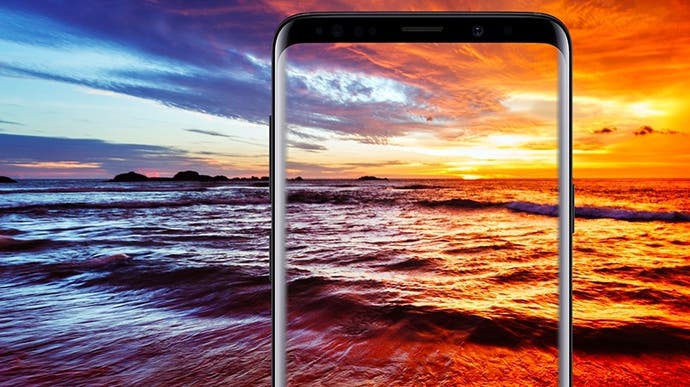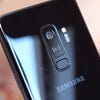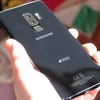Samsung Galaxy S9 review
Is Android's new flagship the best smartphone money can buy?
While it may not have been the company which started the trend - some would argue that honour falls to Xiaomi with its stunning Mi Mix - Samsung is arguably the firm that popularised the concept of a 'big screen' smartphone. The promotional campaign for last year's Galaxy S8 asked consumers to 'unbox' their handsets, stripping away those cumbersome display bezels to embrace the wonder of the 18:9 aspect ratio screen. Samsung's superb Infinity Display was unquestionably the highlight of that model - and of the Galaxy Note 8, which followed shortly afterwards. However, you're only as good as your last product in the fast-paced and competitive smartphone market, and with practically all of its rivals hopping on board the big-screen bandwagon - most notably Apple with its iPhone X - Samsung needs something remarkable to steal back those valuable column inches in 2018. What we've been given is a device which isn't revolutionary, but is still arguably the best smartphone money can buy right now.
In a move that mimics Apple's two-year design cycle, Samsung has opted to evolve the design of the S8 rather than overhaul it, which isn't an entirely unreasonable approach when you consider how attractive last year's model was. It's once again available in two sizes - the standard S9 and the more substantial S9 Plus - the latter of which is the focus of this review. The design language between the S8 and S9 is practically identical, with a glass front and back sitting on a sturdy metal frame. The rounded corners give the device a pebble-like feel - the norm for most modern smartphones these days - and the front is predictably dominated by 2960x1440 pixel Super AMOLED display - 5.8 inches on the S9 and 6.2 inches on the S9 Plus.
While Apple's iPhone X has gone for an extreme full-screen look - albeit with that 'love it or hate it' notch at the top - Samsung has kept things mostly the same this year; the minimal bezels remain in place, with the top bezel containing elements such as the front-facing camera, iris scanner and earpiece. Samsung's Infinity Display lacks the impact it had last year as Apple has essentially gone one better, but it's still a fantastic screen and is a touch brighter than last year's offering too.
Inspecting the S9 Plus closer reveals a great many elements that remain almost unchanged from the S8. All of the buttons are in the same place - volume and Bixby on the left, power button on the right - and the SIM tray still allows you to insert a MicroSD card to bolster the available storage (64, 128 and 256GB models are available). Pleasingly, Samsung has retained the 3.5mm headphone jack at the bottom of the phone, which means that the S9 is a very attractive option if you're looking for a high-end handset with a wired audio connection in 2018.
The other big news on the aural front is that there are now two speakers instead of one; the earpiece doubles as the second speaker, giving powerful stereo sound when you're not using headphones. Samsung-owned AKG Acoustics has tuned both so they provide 40 percent more volume than the single speaker on last year's phone. This aspect dramatically improves the S9's suitability when it comes to watching movies and playing games. AKG has also tuned the headphones bundled with the handset.
Turn the phone over, and the most prominent cosmetic change becomes apparent - and it's one existing owners of the S8 will welcome with open arms (or perhaps fingers). The fingerprint scanner has been relocated to sit below the camera module, making it much easier to reach than it was on the S8, where it was awkwardly placed to the side of the camera. There's no more painful finger-stretching required to hit the admittedly fast and accurate sensor, although it remains a little on the small size and you'll still end up mistaking the camera for it on occasion. Despite this niggle, it's a marked improvement - which is highly fortunate as Samsung's attempt to replicate Apple's much-hyped Face ID security system is something of a bust.
Like many other Android phone makers, Samsung has used eyeball scanning as a means of unlocking phones for a while now, but Apple's Kinect-style 3D camera has upped the stakes dramatically - so much so that the Cupertino company removed the fingerprint scanner entirely from the iPhone X. Samsung has now combined its iris-scanning system with a facial recognition approach to create what it calls Intelligent Scan. It sounds grand, but in reality, all the phone is doing is using iris scan first, then if that fails to find your eyeballs, it falls back to the face recognition system. Because the phone lacks the fancy 3D camera seen on the iPhone X, all it's doing is comparing your face to the 2D image it has committed to memory.
Furthermore, the setup procedure insists that you remove any glasses you're wearing, so spectacle wearers are at a distinct disadvantage. Even when it does work, the system is painfully slow to register your face (or eyes) and unlock the phone, which is a real disappointment as OnePlus' face unlock tech works brilliantly on the OnePlus 5 and 5T, using a similar setup. Thank goodness then that Samsung didn't 'do an Apple' and ditch the fingerprint scanner, as it remains by far the best way to unlock the S9 Plus.
Fingerprint scanner placement aside, it's clear that all of the big changes in the Galaxy S model this year take place under the bonnet. As has been the case in previous iterations, the actual silicon you have inside your S9 Plus depends entirely on where in the world you happen to reside. In Europe, the Middle East and Africa, you get the Samsung-made Exynos 9810 Octa SoC. Conversely, in North America and China, the phone is powered by the Qualcomm Snapdragon 845 and the Adreno 630 GPU. Based on these tests at least, the Snapdragon version does appear to have the edge performance-wise, though some tests, Geekbench CPU benchmarks specifically, do see the Exynos pull ahead. Meanwhile, the S9 has 4GB of RAM while the S9 Plus has 6GB.

| Galaxy S9 Plus | iPhone X | iPhone 8 | Galaxy Note 8 | Galaxy S8 | Galaxy S7 | |
|---|---|---|---|---|---|---|
| Geekbench Single-Core | 3673 | 4199 | 4190 | 1867 | 1993 | 1801 |
| Geekbench Multi-Core | 8749 | 10064 | 10062 | 6663 | 6665 | 5278 |
| 3DMark IceStorm Unlimited | 39404 | 63787 | 62360 | 38960 | 31661 | 27370 |
| GFXBench T-Rex | 144.0 | 184.4 | 179.6 | 116.0 | 120.0 | 87.0 |
| GFXBench Manhattan | 77.0 | 91.6 | 89.5 | 61.0 | 64.0 | 29.0 |
Just as night follows day, it almost goes without saying that the S9 Plus' internal hardware outpaces last year's model. Performance is silky-smooth no matter how much load you place on the processor; the generous 6GB of RAM on the Plus means apps rarely get closed down for memory management reasons, so you can happily switch between multiple processes without any lag or pauses. 3D gaming is a good way of judging a phone's potential, and the S9 Plus chews through the majority of the games we tested on it; Real Racing 3 - hardly a spring chicken - runs as smooth as butter, while Tekken - quite a recent release - also plays perfectly. That said, there are still some games that are so poorly optimised on Android that they stutter even on S9 Plus; Final Fantasy 15 Pocket Edition was perhaps the worst offender during our testing period. Ultimately, the massive screen is the ideal canvas for gaming - or indeed any kind of media consumption - and Samsung has included useful options for gamers, such as the ability to mute notifications while playing or record gameplay.
In terms of software, the S9 Plus is running Android Oreo, the latest version of Google's mobile OS. Laid on top of this is Samsung's custom TouchWiz skin, which has its own unique look which sets it apart from phones using stock Android, like the Pixel 2 and Razer Phone. Samsung has tinkered with the skin quite heavily, introducing features such as customisable themes and the 'Apps edge', which allows you to pin shortcuts to the right-hand side of the screen, opening them up with an intuitive swiping gesture. TouchWiz has matured to become one of the most likeable Android skins, but there are some notable annoyances - such as Samsung's continued insistence on needlessly duplicating functionality already present in Google's core suite of applications.
The Samsung-made selection includes a gallery app, payment app, app store and virtual assistant, all of which are inferior to Google's Photos, Play Store and Assistant app. Bixby - Samsung's stab at the AI helper concept - has gotten a little more useful since last year and can even recognise items using the handset's camera, but it's still a poor second to Google Assistant, despite having its own dedicated hardware button. Mercifully, you can now disable this button entirely to prevent yourself from accidentally waking Bixby. Bloatware is still an issue as well, with Microsoft's deal with Samsung ensuring that apps like Word, Excel, Powerpoint are installed by default. Annoyingly, you can't totally remove these apps and free up storage space, but you can at least disable them so they no longer appear in the phone's app drawer.
The Galaxy S9's photographic performance is something Samsung has placed front and centre in its marketing for the device, with the new variable-aperture sensor offering a mechanical advantage over traditional fixed-aperture cameras. The concept is simple; the phone's main 12-megapixel camera - which also boasts 'Dual Pixel' phase detection autofocus (just like last year's model) and OIS - can swap between f/1.5 and f/2.4, depending on the available light in any given situation. The former is excellent for shooting in low-light conditions as it allows more light into the sensor, but using the 'Pro' shooting mode, you can manually enable the f/1.5 setting and use it to create artistic shots with a neat blurring effect (the wider the aperture, the shallower the depth of field). The more traditional f/2.4 aperture is perfect for everyday shots in good light when you want everything in the frame to be in perfect focus.
While we're not sure its rivals will be rushing to replicate this particular hardware feature - especially when phones like the Pixel 2 are capable of excellent low-light performance using a single aperture lens - there's no denying that the Galaxy S9 Plus is more versatile when shooting in darker environments. Outside of this party trick, photo quality is superb and the phone focuses and shoots quickly thanks to the Dual Pixel system, which effectively uses two angles to lock on and focus instead of one. The second 12-megapixel snapper on the S9 Plus offers x2 optical zoom and allows for 'Live Focus' bokeh effects.
The other big news with the Galaxy S9 Plus' camera is the ability to shoot super slow-motion video - something that is made possible by the integrated DRAM in the camera module. The phone can record video at 960fps, which results in astonishingly smooth slow-mo. There are some caveats to consider here; you can only record around 0.3 seconds of footage in super slow motion, and that footage is captured at 720p resolution (the phone is capable of 4K, 60fps recording otherwise). This isn't an issue in itself - the footage looks incredible - but actually deploying the super slow-mo recording is quite a frustrating affair. You can either choose to record footage and allow the phone to decide when to activate slow-mo (it looks for areas of movement within the frame and then triggers the effect) or you can grab 0.3 seconds of slow-motion manually. Neither method proves satisfactory; with the latter, it's a case of hoping that the phone picks out the right moments, and with the former, you can only grab short bursts of video. Still, it's an impressive feature when it works, and we imagine Samsung will refine its execution in future phones.
In a somewhat less welcome move, Samsung has taken it upon itself to ape Apple's Animoji system, introduced on the iPhone X. The Galaxy S9's front-facing, auto-focus camera takes a photo of your face and turns it into an 'AR Emoji' which can then be used in animated gifs. The issue here is that the S9 isn't using a super-accurate 3D camera to map your face like the iPhone X, and that means the resultant avatars don't look all that convincing. Also, when animating these creations, it's not anywhere near as accurate at picking out facial movements, and the overall effect is so unsettling it's hard to see many owners making use of it out of anything other than pure curiosity. It's such a throwaway addition that Samsung really shouldn't have bothered; all AR Emoji does is show that the South Korean company hasn't quite gotten out of the habit of copying Apple.




Onto the more mundane stuff, and the phone's battery hasn't taken a big jump over the S8 - there's a 3000mAh cell inside the standard S9 and a 3500mAh battery in the S9 Plus - so stamina is largely unchanged. Samsung's aggressive power-saving modes will help you wring every last drop of juice out of a single charge, but like most modern phones, this one will need charging on a daily basis. Quick-charging and wireless charging are both present, and there's dust and water protection, too. Call quality - yes, this is a phone, remember - is superb, with the earpiece delivering excellent audio.
Overall, the Galaxy S9 is another winner from the South Korean giant, even if, fundamentally, what we're getting is a new phone in an older casing. All of the big changes on the Galaxy S9 Plus - and the standard S9 - take place on the inside; the outer shell is almost identical to last year's device. While there are a lot of elements in this package which don't work as well as they possibly should - AR Emojis being the prime example - there's no escaping the fact that in the fast-changing world of Android smartphones, the S9 Plus is the best that money can buy right now.
The design remains fantastic, the screen is perhaps the best in the smartphone arena and the camera is even smarter this time around, with the variable aperture system dramatically improving low-light shooting, as well as giving access to some clever depth-of-field effects when taking photographs in bright environments. In terms of raw power, it doesn't trump the A11 Bionic processor found in iPhone 8 and iPhone X, but the S9 Plus is a beast when compared to non-Apple handsets. It's an evolution rather than a complete overhaul, but the S9 Plus is built on solid foundations and should be more than enough to keep the Android faithful happy - until Google lifts the lid on this year's Pixel offering, of course.
Samsung Galaxy S9 Plus review unit kindly provided by Mobile Fun.





















